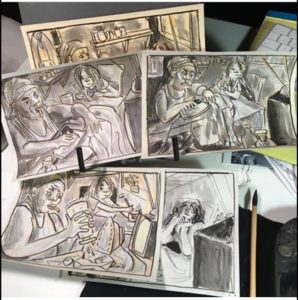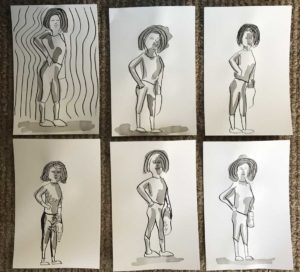I have been learning so much from cartoonist and accidental professor Lynda Barry. Her recent books have been profoundly informative about her creative process. I went to her Wisconsin workshop last November. As I anxiously awaited for that big day to arrive, I acquired several more of her books as companions to Syllabus, the book that introduced me to her work. The one that spoke deeply to me was 100 Demons, in which she discussed various formative events in her life along with a quick primer at the end on the art of using a Chinese paint brush with an ink stone and grinding ink. One of these brushes appears in the picture shown above.
I absolutely love it when Lynda shares her process and her working environment with us, and she does this frequently on social media. For me, it gives me hope. Not hope that I can be just like her if I only master her processes and techniques because there is only one Lynda Barry. But hope that I can be a better version of myself. Hope that there is something inside of me waiting to get out if I will only get busy working.
The thing that I notice in my students and if I’m honest, in myself as well is the tendency to want to short-circuit things. We want a simple fix. We want instant expertise, but it doesn’t work this way. In recent days, Lynda has been sharing one simple truth with us.
Insight takes time to acquire. Don’t try to rush it.
The thing that I always want to pass along to students, and keep in the forefront of my own mind is that nothing worth achieving comes easily or on the first try. So often we bang something out in response to an assignment or an idea and call it good. We think we are done after one iteration! True greatness doesn’t work that way.
Look at how many different times Lynda Barry has drawn the exact same scene. She is trying to gain understanding by staying in motion. She writes:
Something starts to happen when I draw the same scene a dozen times from memory. The drawings don’t get better or worse as I go. Instead the scene seems to come in and out of focus. I have to really push past wanting to stop. (Emphasis mine) when I can’t tell where it’s going to get to this other thing I can’t see while it’s happening.
I decided to experiment with this process, making several versions of the same image as well.
Her comment this morning about having to push past wanting to stop is what anyone who is at the pinnacle of their game has to do every single day. You don’t win the state championship, the gold medal or anything of importance by quitting after the first rep. You have to keep going.
I thought I was doing something special when I made six! I quit when I was only halfway finished. Also, one thing I have noticed about some of these recent drawings as compared to the drawings I was making at Lynda’s workshop when I look back at them is that I was drawing backgrounds with most every image and now I seem to have nothing to say about the background scenery.
Just look at the exquisite detail in the pictures L.B. has posted above. Obviously she has been doing this a long time, and probably can make detailed images like these much faster than regular people, but even so, a dozen images like what she’s showing us took her some time to make. I suspect it would take me an hour to make one picture that even approaches what she’s showing here. Next time, I will block out more time and try to make 12 iterations, remembering to include background details.
Thank you Lynda Barry, for showing us what greatness looks like.

